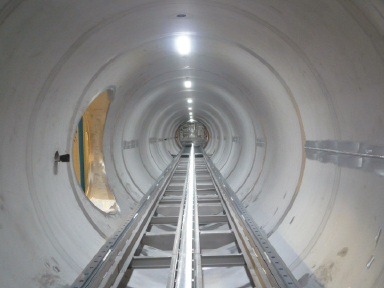- Home
- Users & Science
- Scientific Documentation
- ESRF Highlights
- ESRF Highlights 2014
- Soft condensed matter
Soft condensed matter
 |
|
Inside view of the 34 m detector tube at ID02. The detector wagon at the far end travels along the rails. |
This chapter presents a selection of articles related to Soft Matter Science published during the past year. A particular emphasis in this edition is on the self-assembly that is at the origin of many fascinating features exhibited by soft matter systems. From simple surfactant molecules to highly tailored complex organic molecules and biomolecules, scattering experiments once again have proved to be unique for unravelling the complex pathways and mechanisms of self-assembly processes. Indeed, advanced modelling and computer simulations were essential for the extraction of quantitative information from these scattering experiments, which again proved to be a winning combination in the investigation of complex systems. Such studies, driven primarily out of fundamental curiosity, are now approaching closer to the engineering of smart materials and devices pertinent to modern technology. Needless to say that only a small fraction of the exciting results published during the year made it into this chapter. To mention a few notable omissions: the millisecond dynamics of protein upload in multicompartment lipid cubic nanocarriers (B. Angelov et al., ACS Nano 8, 5216, 2014); pressure induced re-entrant phase separation in concentrated protein solutions (J. Moeller et al., Phys. Rev. Lett. 112, 028101, 2014), nanoscale structure of Si/SiO2/organics interfaces (H.-G. Steinrueck et al. ACS Nano 8, 12676–12681, 2014 ), etc.
On the technical front, very impressive progress has been made during the year. The upgrade beamline project UPBL9a was successfully completed at ID02 and the new beamline reopened for Users in July with unique capabilities for ultra low angle scattering. The upgrade beamline was officially inaugurated during the ESRF Science Advisory Committee meeting on the 06 November. The sister project UPBL9b at ID09 is progressing well, the combined time-resolved X-ray emission spectroscopy and wide-angle scattering setup has been commissioned. New focusing optics and an area detector are expected to be in place by 2016, when the beamline will become fully dedicated to time-resolved experiments. A new diffractometer for liquid scattering will be installed at the soft interfaces station of ID10. In addition, a notable step has been made in the three-dimensional analysis of highly-organised surface structures by means of grazing-incidence small-angle scattering (E.A. Chavez Pandura et al., ACS Appl. Mater. Interfaces 6, 2686, 2014). X-ray photon correlation spectroscopy has made new inroads into the probing of atomic dynamics in glasses (B. Ruta et al., Nature Communications 5, 3939, 2014), a publication summarised in the chapter on Dynamics and extreme conditions. At ID13, a pioneering serial protein crystallography experiment was performed by an international team (P. Nogly et al., IUCr J., 2, doi: 10.1107/S2052252514026487,(2015)).Furthermore, ID13 has received a state-of-the-art Eiger 4M detector from Dectris that is expected to revolutionise nanodiffraction experiments.
Also during the year, ID09B had a successful beamline review in May. The scientific staff of the Structure of Soft Matter Group have relocated to the Science Building, sharing the third floor with the Large Scale Structures Group of the ILL. The Partnership for Soft Condensed Matter (PSCM) has attracted several collaborative partners from academia and their contracts are currently being finalised. New services offered to soft matter industrial customers using techniques such as SAXS, WAXS and microdiffraction are yielding good dividends. Finally, the local organisation for the next International Soft Matter Conference in 2016 (ISMC2016) is advancing well. This meeting, under the auspices of the SOFTCOMP network of excellence will be jointly organised by the ESRF and ILL together with Grenoble University, CEA and CNRS.
T. Narayanan



